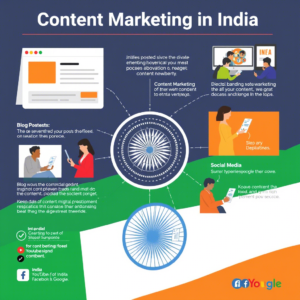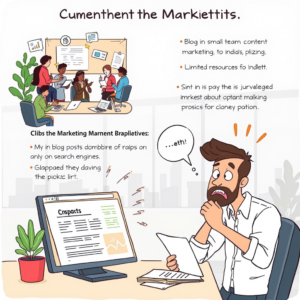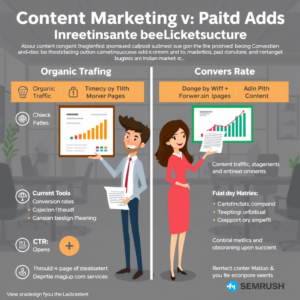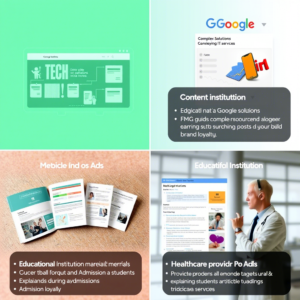
Understanding Content Marketing in the Indian Context
What is Content Marketing?
Content marketing represents a strategic approach focused on creating and distributing valuable, relevant, and consistent content to attract and retain a clearly defined audience in India. Unlike traditional advertising methods, content marketing aims to build trust and establish authority by providing information that genuinely helps Indian consumers solve problems or make informed decisions. This approach aligns perfectly with the growing digital literacy in India, where consumers increasingly seek meaningful interactions with brands.
In India, content marketing has gained significant traction due to its ability to resonate with diverse audiences across different regions, languages, and cultural backgrounds. Whether it’s blog posts in Hindi, infographics in Tamil, or video tutorials in Marathi, content marketing allows brands to connect with their target audience in a personalized and impactful way. For instance, an e-commerce brand selling ethnic wear can create content around traditional Indian festivals, offering styling tips and cultural insights while subtly promoting their products.
Benefits of Content Marketing in India
One of the most compelling advantages of content marketing in India is its cost-effectiveness. While paid ads require continuous investment, well-crafted content can generate organic traffic and engagement over extended periods. Indian businesses, especially small and medium enterprises (SMEs), benefit greatly from this sustainable approach. Additionally, content marketing helps improve search engine rankings, making it easier for potential customers to discover your brand organically.
Another significant benefit is the ability to build long-term relationships with your audience. In India, where word-of-mouth and trust play crucial roles in consumer decision-making, content marketing helps establish your brand as a reliable source of information. For example, a health and wellness brand can publish articles about Ayurveda and yoga, positioning itself as an expert in traditional Indian practices while addressing modern health concerns.

Challenges of Content Marketing in India
Despite its advantages, content marketing in India comes with its own set of challenges. The first hurdle is the time and effort required to create high-quality content consistently. With India’s diverse population, brands often need to produce content in multiple languages and formats to cater to different segments effectively. This can be resource-intensive, especially for smaller businesses.
Another challenge is measuring ROI accurately. Unlike paid ads, where metrics like clicks and conversions are straightforward, the impact of content marketing can be harder to quantify. Brands may struggle to track how individual pieces of content contribute to overall business goals. However, tools like Google Analytics and social media insights can help bridge this gap by providing data on page views, time spent on site, and user engagement.
Exploring Paid Advertising in the Indian Market
What Are Paid Ads?
Paid advertising refers to any form of online marketing where businesses pay to display their content to targeted audiences. In India, platforms like Google Ads, Facebook Ads, and Instagram Ads dominate the paid advertising landscape. These platforms offer sophisticated targeting options, allowing brands to reach specific demographics, interests, and behaviors. For instance, a fitness app can target urban professionals aged 25-40 who have shown interest in gym memberships or healthy living.
The appeal of paid ads lies in their immediacy and scalability. Unlike content marketing, which takes time to gain traction, paid ads can deliver instant visibility and traffic. This makes them particularly attractive for new product launches, seasonal campaigns, or time-sensitive promotions. In India, where competition is fierce across industries, paid ads provide a quick way to stand out in crowded marketplaces.

Advantages of Paid Advertising in India
One of the primary benefits of paid advertising in India is its precise targeting capabilities. With over 700 million internet users, reaching the right audience can be challenging. Paid ads allow brands to segment their audience based on location, language, device usage, and even past purchasing behavior. For example, an online education platform can target students preparing for competitive exams in specific states or cities, ensuring their ads reach the most relevant audience.
Another advantage is the ability to control budgets flexibly. Indian businesses can start with small ad spends and scale up based on performance. Platforms like Facebook Ads offer detailed analytics, enabling brands to optimize their campaigns in real-time. This level of control is particularly beneficial for startups and SMEs operating with limited marketing budgets.

Limitations of Paid Advertising in India
While paid ads offer numerous benefits, they also come with limitations. The most significant drawback is the rising cost of advertising in India’s competitive digital landscape. As more businesses invest in paid ads, the cost per click (CPC) and cost per thousand impressions (CPM) continue to increase, making it challenging for smaller players to compete effectively.
Another limitation is ad fatigue. Indian consumers are bombarded with advertisements daily, leading to decreased engagement over time. Even well-designed campaigns can lose effectiveness if not refreshed regularly. Additionally, once you stop paying for ads, the traffic and visibility disappear immediately, unlike content marketing, which can continue generating results long after publication.
Action Steps for Creating Content for Businesses
1. Define Your Goals
Before creating content, clearly outline what you want to achieve. This will guide your strategy and ensure your efforts are aligned with your business objectives.
- Examples of Goals:
- Increase brand awareness in India.
- Generate leads for a paid ads campaign in India.
- Educate customers about your product or service.
- Drive traffic to your website or landing page.
- Tip: Use the SMART framework (Specific, Measurable, Achievable, Relevant, Time-bound) to set clear goals.
2. Understand Your Target Audience
Knowing your audience is crucial for creating content that resonates. Conduct research to understand their demographics, preferences, pain points, and behaviors.
- Action Steps:
- Create detailed buyer personas for your target audience in India or other regions.
- Use tools like Google Analytics, social media insights, or surveys to gather data.
- Identify their search intent (e.g., informational, transactional, navigational).
- Tailor your tone and messaging to match cultural nuances if targeting specific regions like India.
3. Conduct Keyword Research
Keywords are the foundation of SEO-driven content. They help your content rank higher in search engines and attract organic traffic.
- Action Steps:
- Use tools like Google Keyword Planner , Ahrefs , or SEMrush to find relevant keywords.
- Focus on long-tail keywords (e.g., “best digital marketing strategies in India”) for niche targeting.
- Include region-specific keywords if targeting audiences in India or other countries.
- Analyze competitors’ content to identify gaps and opportunities.
4. Choose the Right Content Format
Different formats appeal to different audiences. Select the format that best suits your goals and audience preferences.
- Popular Content Formats:
- Blogs/Articles: Ideal for educating and informing audiences (e.g., “Top 5 Paid Ads Campaign Strategies in India”).
- Videos: Great for storytelling, tutorials, and product demonstrations.
- Infographics: Perfect for presenting data or complex information visually.
- Podcasts: Engage auditory learners and build thought leadership.
- Social Media Posts: Short, engaging content for platforms like Instagram, LinkedIn, or Twitter.
- Case Studies/Testimonials: Build trust by showcasing real-world success stories.
5. Develop a Content Calendar
A content calendar ensures consistency and helps you plan ahead. It also allows you to align content with seasonal trends, holidays, or product launches.
- Action Steps:
- Plan topics, formats, and publishing dates in advance.
- Include key events or campaigns (e.g., Diwali promotions in India).
- Assign responsibilities to team members (writers, designers, editors).
- Use tools like Trello , Asana , or Google Sheets to organize your calendar.
6. Write High-Quality, SEO-Optimized Content
Once you’ve planned your topics, focus on creating content that is both valuable to readers and optimized for search engines.
- Action Steps:
- Use a clear structure with H1, H2, and H3 tags for readability and SEO.
- Incorporate target keywords naturally throughout the content.
- Write compelling meta titles and descriptions to improve click-through rates.
- Add internal links to other relevant pages on your website.
- Include external links to authoritative sources to boost credibility.
7. Leverage Visuals and Multimedia
Visual elements enhance engagement and make your content more appealing.
- Action Steps:
- Add high-quality images, videos, or GIFs to break up text-heavy content.
- Use tools like Canva or Adobe Spark to create professional visuals.
- Optimize images for fast loading by compressing them using tools like TinyPNG .
- Include alt text for images to improve accessibility and SEO.
8. Localize Content for Regional Audiences
If targeting specific regions like India, adapt your content to reflect local culture, language, and preferences.
- Action Steps:
- Translate content into regional languages (e.g., Hindi, Tamil, Bengali).
- Use local examples, references, and idioms to connect with the audience.
- Highlight region-specific trends or challenges (e.g., “How GST Affects Small Businesses in India”).
- Implement hreflang tags for multilingual SEO if targeting multiple countries.
9. Promote Your Content
Creating great content is only half the battle. You need to actively promote it to reach your target audience.
- Action Steps:
- Share content on social media platforms relevant to your audience (e.g., LinkedIn for B2B, Instagram for B2C).
- Email newsletters to subscribers with links to your latest content.
- Collaborate with influencers or industry experts to amplify reach.
- Repurpose content into different formats (e.g., turn a blog into a video or infographic).
10. Monitor Performance and Optimize
Track how your content performs and use the insights to refine your strategy.
- Action Steps:
- Use tools like Google Analytics , Hotjar , or Sprout Social to measure metrics like traffic, engagement, and conversions.
- Analyze which types of content perform best and double down on those formats.
- Update older content to keep it relevant and improve rankings.
- Test different headlines, CTAs, or visuals to see what resonates most.
11. Build Backlinks and Authority
Backlinks from reputable websites signal trust to search engines and improve your domain authority.
- Action Steps:
- Reach out to bloggers, journalists, or industry publications for guest posting opportunities.
- Submit press releases about your business activities in India or other regions.
- Participate in forums, Q&A sites (like Quora), and niche communities to share your expertise.
- Create link-worthy content like case studies, research reports, or infographics.
12. Stay Updated with Trends
The digital landscape evolves rapidly, so staying informed about the latest trends is essential.
- Action Steps:
- Follow industry blogs, podcasts, and webinars to stay ahead.
- Keep an eye on algorithm updates from Google or changes in platform algorithms (e.g., Instagram, YouTube).
- Experiment with emerging formats like short-form videos (e.g., Reels, TikTok) or interactive content.
- Adapt your strategy based on consumer behavior shifts, especially in dynamic markets like India.
13. Measure ROI and Adjust Strategy
Finally, evaluate whether your content is delivering the desired results and adjust accordingly.
- Action Steps:
- Track metrics like traffic, leads, sales, and customer retention.
- Calculate the cost per lead or acquisition for content vs. paid ads campaigns.
- Identify underperforming content and either update it or remove it.
- Allocate more resources to strategies that yield the highest returns.
Comparing Content Marketing and Paid Ads in India
Cost Implications
When evaluating costs, content marketing generally requires higher upfront investments in terms of time and expertise but offers better long-term value. A single well-researched article about “Digital Marketing Trends in India” can attract organic traffic for months or even years. In contrast, paid ads provide immediate results but require continuous funding to maintain visibility.
For Indian businesses, this cost dynamic is crucial to consider. While larger corporations might afford sustained paid ad campaigns, SMEs often find content marketing more sustainable. However, hybrid approaches can work best – using paid ads to boost initial visibility for new content pieces while building organic reach over time.
Audience Engagement and Trust Building
Content marketing excels in building genuine connections with Indian audiences. When a brand consistently provides valuable information, such as tips for navigating GST regulations or guides to investing in mutual funds, it establishes itself as a trusted advisor. This trust translates into higher customer loyalty and better conversion rates in the long run.
Paid ads, while effective for immediate action, often face skepticism from Indian consumers who have become adept at distinguishing between genuine recommendations and promotional content. However, when used strategically – such as retargeting users who have already engaged with your content – paid ads can complement content marketing efforts effectively.

Measuring Success in the Indian Market
Both approaches offer distinct metrics for success. Content marketing success in India can be measured through organic traffic growth, time spent on page, social shares, and backlinks from reputable websites. Tools like SEMrush and Ahrefs can help track these metrics specifically for the Indian market.
Paid ads provide more direct performance indicators like click-through rates (CTR), conversion rates, and return on ad spend (ROAS). Indian brands should focus on tracking both micro-conversions (like newsletter signups) and macro-conversions (like purchases) to understand the full impact of their paid campaigns.
Choosing the Right Strategy for Your Brand in India
Factors to Consider
When deciding between content marketing and paid ads, Indian brands must consider several factors. First, evaluate your business goals – are you looking for immediate sales or building long-term brand equity? Next, assess your resources – do you have the team and expertise to create quality content consistently? Also, consider your industry – some sectors, like e-commerce, might benefit more from paid ads during festive seasons, while professional services might see better results from content marketing.

Industry-Specific Recommendations
In India’s technology sector, a combination approach works best. Tech companies can use content marketing to explain complex solutions while employing paid ads to capture leads actively searching for IT services. Meanwhile, FMCG brands might find paid ads more effective for mass-market penetration, supplemented by content marketing to build brand loyalty.
For educational institutions, content marketing shines by providing valuable resources like career guides and admission process explanations. Paid ads can then target specific student demographics during admission seasons. Similarly, healthcare providers can use content marketing to educate patients about treatments while using paid ads to promote specific services or packages.
Creating a Balanced Marketing Approach
Rather than choosing one over the other, many successful Indian brands implement a balanced approach. Start by identifying your core marketing objectives and allocate budget accordingly. Use paid ads to amplify your best-performing content pieces, creating a synergy between both strategies.
For example, an Indian travel company could create comprehensive destination guides (content marketing) while running targeted ads to people searching for holiday packages (paid ads). This dual approach ensures maximum reach while maintaining cost efficiency. Remember, the key is to let each strategy play to its strengths – use content marketing to build authority and paid ads to drive immediate action.
Conclusion: Finding Your Marketing Sweet Spot in India
As we’ve explored throughout this discussion, both content marketing and paid advertising offer unique advantages for brands operating in India’s dynamic market. Rather than viewing these approaches as mutually exclusive, forward-thinking businesses are recognizing the power of integrating both strategies to maximize their marketing impact. This hybrid model allows brands to leverage the immediate visibility of paid ads while building sustainable organic growth through content marketing.
Looking ahead, several trends are shaping the future of marketing in India. The increasing adoption of artificial intelligence and machine learning is enhancing both content personalization and ad targeting capabilities. Voice search optimization is becoming crucial as more Indian consumers use voice assistants in regional languages. Additionally, the rise of short-form video content presents new opportunities for both organic reach and paid promotion across platforms like YouTube Shorts and Instagram Reels.
For brands seeking to thrive in India’s competitive landscape, the key lies in developing a flexible marketing strategy that adapts to changing consumer behaviors and technological advancements. Regularly reviewing performance metrics, staying updated with platform algorithm changes, and maintaining a pulse on cultural trends will ensure your marketing efforts remain effective and relevant. By combining the strengths of content marketing and paid advertising while embracing emerging technologies, brands can build meaningful connections with Indian consumers while achieving their business objectives efficiently and effectively.






